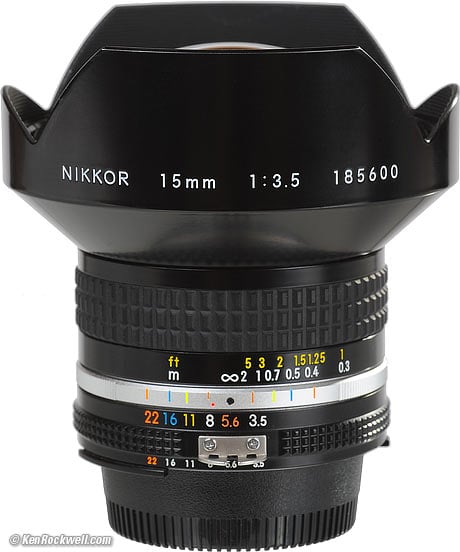Home Donate New Search Gallery Reviews How-To Books Links Workshops About Contact
Nikon
15mm f/3.5
NIKKOR AI-s (1978-2006)
© 2012 KenRockwell.com
Intro Specifications Performance Recommendations
Nikon 15mm f/3.5 AI-s (rear bayonet filters, 22.1 oz./627g, about $1,000 used). enlarge. This free website's biggest source of support is when you use any of these links, especially this direct link to this lens at eBay (see How to Win at eBay), or to it at Adorama, when you get anything, regardless of the country in which you live. Thanks! Ken.
March 2012, January 2008 Nikon Reviews Nikon Lenses All Reviews
Note: This review is still two-sided and I need to clarify it. I had one of these in the 1990s I used on film, which wasn't very good, and just got one to use on the D3, which works very well.
Nikon Ultra-Ultrawide Lens Comparison 23 December 2008
How to Use Ultrawide Lenses 11 August 2008
Introduction top
Intro Specifications Performance Recommendations
This Nikon 15mm f/3.5 manual focus lens works great on my D3.
I've always loved this 15mm since long before I could afford one. The 15mm was Nikon's widest practical lens in the 1980s when I started shooting with Nikon. (The built-to-order 13mm was wider, but cost about what my dad earned in several months, so it didn't really exist.)
As a high school and college kid, I lusted after this thing for a decade until I finally was able to find one used in 1994, when I both had a real job and some insurance money that needed to be spent or lost. It was still an impulse buy.
I've always loved its exterior appearance. It was, and still is, a bizarre and expensive exotic. It's always sold new for $2,000 and up at NYC discount prices. Today in 2010 it sells used for about $1,000.
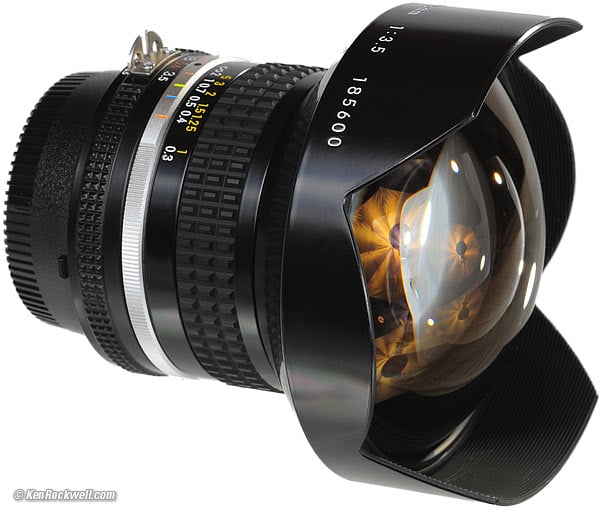
Nikon 15mm f/3.5 AI-s.
I love the outside appearance of the 15mm. It just looks perfect and well proportioned. It looks far-out, but it's actually a reasonably sane lens to carry around all day, unlike the behemoth 14-24mm AFS. It's as easy or easier to focus than a 50mm: just flick a finger.
The manual focusing is just perfect, and the image quality is outstanding because this 15mm has virtually no straight-line distortion. Most Nikon wide lenses, especially the 14-24mm AFS and 14mm f/2.8 AF, tend to bend straight lines slightly. The fact that this 15mm keeps lines ruler-straight, so long as you're at least 10 feet (3m) away, makes this 15mm lens uniquely handy for architectural photography.
Regardless of the so-called built-in hood, the huge fish-bowl front element collects light from every direction and often leaves huge fuzzy ghost blobs if you're not careful to shield the lens from the open sky or open windows indoors.
The advantage of this 15mm ultra-ultra-wide over the 14-24mm AFS and 14mm f/2.8 AF is that is has much less distortion, probably weighs less, and costs less. The disadvantage is far more ghosting. The lack of autofocus isn't significant at these focal lengths, since everything is usually in focus anyway.
For most people, the newer 14mm f/2.8 makes more sense, since it's about the same size and weight and a better lens overall, and doesn't cost that much more than a used 15mm (about $1,500 new). The 14mm f/2.8 has a little more weird distortion.
The 14-24mm zoom is in a size, weight and performance class all its own. It's the world's sharpest ultra-ultra wide lens, but is huge and has a lot more, but easily correctable, distortion.
Size Comparison: This 15mm lens is the second lens from the left.
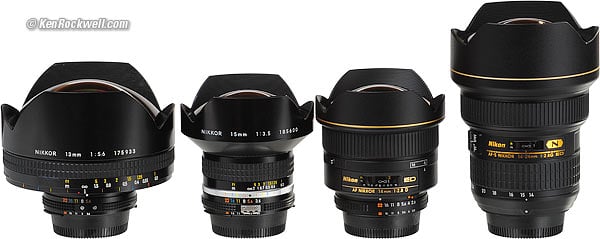
Nikon 13mm f/5.6 AI-s, 15mm f/3.5 AI-s, 14mm f/2.8 AF-D and 14-24mm AFS.
It's these special techniques and size that steered me away from it after I owned my first one. I'm lazy and like to travel light. Compared to a 20mm, the 15mm is big and heavy (close to 4" in diameter).
It is a rectilinear lens, which means that straight lines remain straight. It is not a fisheye. After using it your 20mm will seem almost like a telephoto.
If you are reading this you are probably just like me. I lusted after this lens since the late 1970s. In 1990 I almost bought one, until I realized that for less money I could buy a 4x5 camera and a lens with the same angle of view and get far superior results, so I bought a 4x5 camera. In 1995 I finally found a 15mm used and bought it on a whim. As you can see, I wasn't that impressed for my uses and sold it. That's the advantage of used Nikkor lenses: you can sell used Nikkor lenses for whatever you pay for them.
When I shoot 35mm I want it fun and easy because if I'm going to spend any time at it I'm going to shoot 4x5 instead.
I found that it was too wide even for my tastes, and I love super wides. In practical outdoor photography it simply is difficult to find a natural scene where there is compelling content over as large an area as this lens covers. It is so wide that unless you are on a real set or studio where you are in complete control there will probably be some distracting element towards the sides of the image.
If you are a beginning photographer you probably want the widest wide-angle lens you can get, to ensure that you "get everything in." If you are an accomplished photographer you now realize how stupid you were when you started. A wide-angle lens is the best way to make a bad landscape photo simply became it does get everything in, including all the distracting items. A good photograph needs to give the viewer a clear image of a single idea. Therefore wide-angle lenses are the most difficult to use effectively because they can include so many potentially distracting elements.
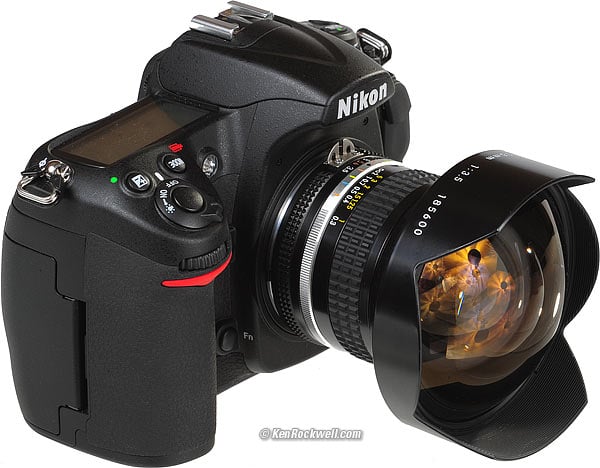
Nikon 15mm on Nikon D300.
Compatibility
This is an expensive ultra-ultra-wide lens for use on FX and film. It's wasteful to use this on a DX camera, but it works fine if you insist.
On the D2, D3, D200, D300 and F6, use the "Non-CPU Lens Data" menu option to input 15mm and f/3.5. This gives full matrix metering and EXIF data, and finder read-out of set aperture. It works great in aperture-preferred as well as manual modes on these cameras.
It won't couple well to the cheaper digital (D80 and below) and cheaper film cameras (N80 and below). It works perfectly every professional film camera (F, F2, F3, F4, F5, F6), with Matrix metering on the FA, F4 and F6.
See Nikon Lens Compatibility for details on your camera. Read down the "AI, AI-s"column for this lens.
Production History
Nikon has made two optical variations of 15mm non-fisheye lenses.
The first 15mm was an f/5.6 with 14 elements in 12 groups with CRC. Filters were built-in.
The 15mm f/5.6 was introduced in 1973 and made through 1978. It originally was not AI, and was updated to AI around 1977. Smarter people had their pre-AI lenses converted to AI by Nikon back when they could.
This 15mm f/3.5 came out in 1978 as an AI lens. It had an all-black barrel. Filters are now rear bayonet and the optics are 14 elements in 11 groups, also with CRC. The newer f/3.5 lens is a little longer, thinner and lighter than the older f/5.6.
This AI-s version replaced the optically identical AI version in 1981. This AI-s version was made through 2005, and has a silver grab ring into which the depth-of-field marks are engraved.
Nikon made about 9,000 of these 15mm f/3.5 AI-s lenses. It made about 2,000 of the 15mm f/3.5 AI, or a total of about 10,000 of all 15mm f/3.5 lenses.
Nikon only made a total of about 3,000 of the f/5.6 versions.
Price History
These are NYC discount prices. Before 2000, few people knew how to mail or telephone order from NYC and therefore paid far more at local camera stores.
Price, new* |
Price new, unadjusted |
|
| 1977 June (f/5.6 version) | $2,900 |
$805 |
| 1986 June (f/3.5 AI-s) | $1,800 |
$910 |
| 1987 June | $2,100 |
$1,099 |
| 1991 December | $2,300 |
$1,485 |
| 1992 December | $2,100 |
$1,430 |
| 1995 December | $2,800 |
$2,000 |
| 1996 December | $2,700 |
$2,000 |
| 2008 January (used) | $700 - $1,000 |
|
| 2010 October (used) | $800 - $1,400 |
* adjusted for inflation, 2008.
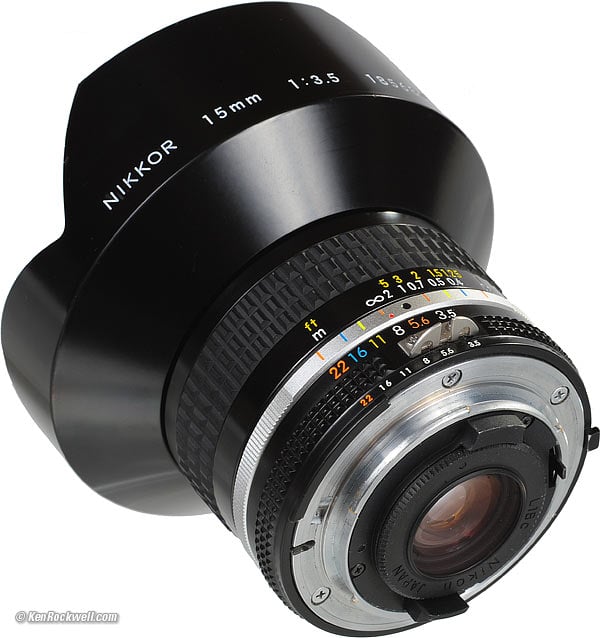
Nikon 15mm f/3.5 AI-s.
Specifications top
Intro Specifications Performance Recommendations
Name
Nikon calls this the Nikon AI Nikkor 15mm f/3.5s.
Optics
14 elements in 11 groups. Multicoated. Spherical optics with floating-element close-range correction (CRC).
Close Focus
1 foot or 0.3 meters.
Diaphragm
7 blades stopping down to f/22, not that you'd ever want to stop down below f/11.
Filters
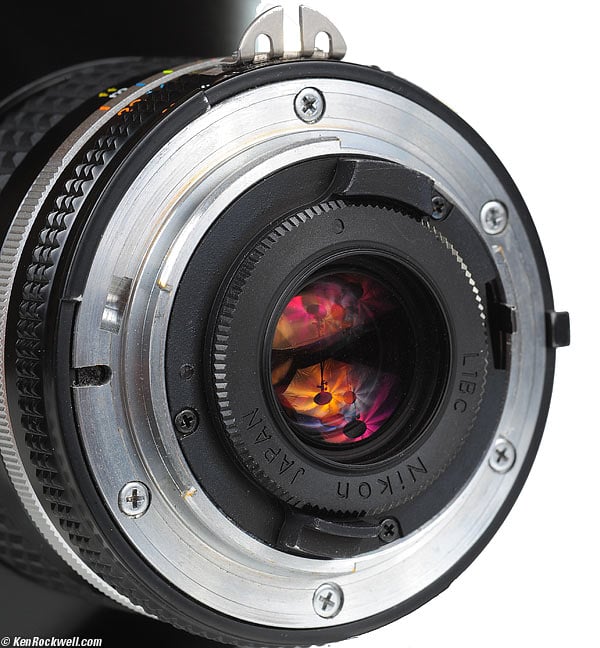
Rear bayonet filter on Nikon 15mm f/3.5.
Rear bayonet.
L1Bc, A2, B2 and O56 filters included in CA-2 case.
The filter case fits inside a secret compartment in the top of the case.
Front filters don't attach, another reason this is a difficult lens to use well.
Size
3.309" extension from flange x 3.543" diameter (84.06 x 90.00mm), measured.
Nikon specifies 3.7" overall x 3.5" diameter (94 x 90mm).
Weight
22.120 oz (627.15g), measured, naked.
Nikon specifies 22 oz (630g). Complex front cap weighs an additional 2.365 oz. (67.0g).
Case
CL-17 lens case, included when new.
CA-2 filter case.
Hood
None.
The petal-like metal protrusions at the front are mostly for mechanical protection, even though NIkon claims they are a built-in hood. I've made a large (1 foot or 30 cm) custom rectangular matte box out of foam core covered with black fuzzy contact paper for mine.
Caps
Standard rear cap.
Specialized 90K felt-lined metal front cap.
Performance top
Intro Specifications Performance Recommendations
It is rare among Nikkor wide-angles because it is one of only about two lenses that is free from barrel distortion. That means that straight lines stay perfectly straight in the image, and don't bend out ever so slightly as they do with most of the other wide angles and zooms. The only other Nikkor wide angle I've used that shares this is the fantastic and inexpensive 28mm f/2.8 AI-s. Both the 28mm f/2.8 AI-s and this 15mm have linear distortion at close distances.
When used outdoors, light from the sky will cause blue flare blobs to appear on the bottom of your image. You may or may not see this. If you have a dark enough image bottom and give enough exposure, you will. If you are indoors and there is a bright window in the scene (or even out of the image off to one side), the light from that window will also cause a big blue blob.
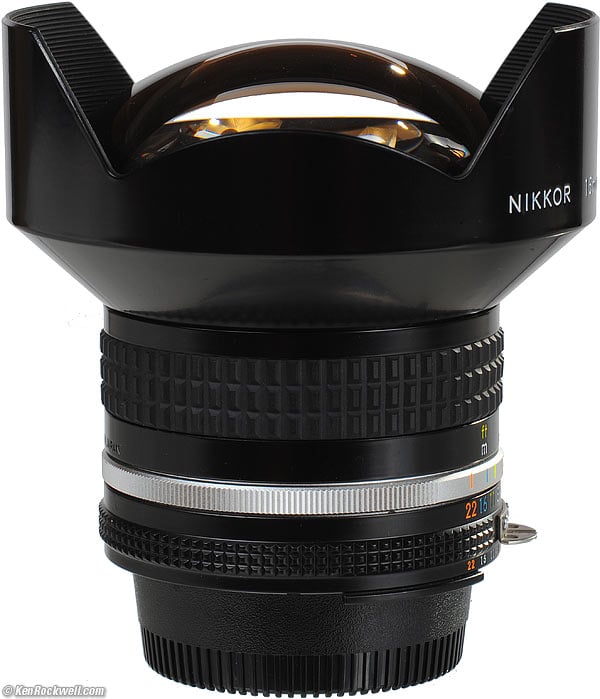
Side view of Nikon 15mm. You can see through the glass to the other side!
The petals serve only for mechanical protection against banging the front of the glass against a wall. Since the front element curves out so much, light can still get in from almost every angle. It gets in this big fishbowl, bounces around, and can come out as big reflective blobs in the darker parts of your image.
It has a good deal of ghosting. That means if you have the sun or other light source in the image that you will get all sorts of little light blobs arranged along the line that runs through the light source and center of your image.
What looks like a built-in lens shade isn't. The scalloped front of the lens really is just mechanical protection for the front element. Just as you can see the element from any angle, likewise stray light is getting into the front element from every angle.
The 15mm is weird for sharpness. The physics of diffraction and the angles seen by ultra wide-angle lenses limit the sharpness (tangential resolution or MTF) in the corners as one stops down. Therefore, due to the fact that one usually has more than ample depth-of-field even at large apertures, one tends to get sharper results at larger apertures. I got the best results at f/8, so typically I'd run a camera in the aperture-preferred (A) mode and leave the lens at f/8.
I found wonderful evenness of illumination. Except for the biggest two apertures, as typical for Nikon, the frame was evenly illuminated. This is better than Nikon's instruction sheet claims, which warns that there is falloff in the corners. I found none for practical photography. This is an advantage of a retrofocus lens. Unlike lenses for large format cameras that require center filters, this 15mm doesn't.
Sharpness on D3
f/3.5: Soft.
f/4: Soft.
f/5.6: Better; oddly soft in a band about r=10mm.
f/8: Very good, almost perfect except for the last millimeter of the corners.
f/11: Perfect, even out to the farthest corners. f/11 is the optimum aperture.
f/16: A little dulled in the center from diffraction, maybe a tad sharper in the very far corners.
f/22: Duller from diffraction.
Sharpness on Film
This is how my first 15mm performed on Fuji Velvia 50 in the 1990s: (D3 update soon!)
f/4: perfect, sharp center. Coma causes loss of contrast at sides, although the resolution is good
f/5.6: pretty good all around. Some coma still at edges. The field curvature is in the direction that is ideal for photographing interiors
f/8: nice (but not outstanding) all over. This is the optimum aperture.
f/11: nice all over, but the corners are starting to get dull due to diffraction.
f/16: starting to loose it in corners. The lateral chromatic aberration is starting to be obvious in the corners
f/22: Corners soft due to diffraction. Lateral chromatic aberration obvious in corners.
Recommendations top
Intro Specifications Performance Recommendations
It is poor for casual use outside of a studio. The problem is that the huge front element collects light from every angle, even outside the image. This light bounces around inside the front of the lens and places it in your image as huge blobs of blue flare. These flare blobs appear on the opposite side of the image from the source of the light.
To use this lens one needs to ensure that assistants have goboed the lighting to prevent any stray light from hitting the lens. Outdoors one either needs big gobos or a huge custom hood or matte box.
I had to make a huge custom lens hood when I used this lens outdoors in nature. My hood was made of Foam-Core and covered in black flocked contact paper. The front of this hood was about 8x12" and pushed over the front of the lens. It needs to be this big to be able to cut off stray light efficiently.
Today I'd suggest that you rent this lens first to see how you like it.
I'd also suggest considering the Tokina 17mm f/3.5 SL manual focus lens that sells for about $230 brand new. I found it easier to get good results with the Tokina, plus it is much easier to carry and even takes screw-in 67mm filters.
Without all this expense and effort my 20 year old Tokina 17mm f/3.5 SL series (bought used for $150) works better. It has a little more distortion typical to more common lenses, but has none of the blue blob ghosts. It is just as sharp.
Watch it with the 15mm Nikkor lens. I found these blue flare blobs significant, and they are a pain to avoid.
Forget filtration with the 15mm. It only takes Nikon's rear bayonet filters. You could mess with gel filters, but I never did.
From what I've read (I have not photographed with these) you also may want to consider the Sigma 14mm f/3.5 AF and f/2.8 AF lenses. Pass on the inferior Tamron.
Also by all means try the new Nikkor 14mm f/2.8 AF. It seems to have cured the flare and ghosting problems although doesn't seem as sharp from a quick test.
All these lenses,
save for the 17mm Tokina, are very similar and may share:
1.) Flare problems
2.) Lack of edge sharpness at small apertures
3.) No front filtration (rear filters only.)
If you don't mind the ghosts, by all means enjoy the 15mm Nikkor. Its freedom from linear distortion make it uniquely good.
Many used samples are missing the AI-coupling prong. This is because people unscrew them for use on on film cameras to get more light on the back of the aperture ring so they can read it through the camera's optical viewfinder through what Nikon calls the "Aperture Direct Readout."
You can read more here about the development of this lens family.
Help me help you top
I support my growing family through this website, as crazy as it might seem.
The biggest help is when you use any of these links to Adorama, Amazon, B&H, eBay, Ritz, Calumet and J&R and when you get anything. It costs you nothing, and is this site's, and thus my family's, biggest source of support. eBay is always a gamble, but all the other places always have the best prices and service, which is why I've used them since before this website existed. I recommend them all personally.
If you find this page as helpful as a book you might have had to buy or a workshop you may have had to take, feel free to help me continue helping everyone.
If you've gotten your gear through one of my links or helped otherwise, you're family. It's great people like you who allow me to keep adding to this site full-time. Thanks!
If you haven't helped yet, please do, and consider helping me with a gift of $5.00.
As this page is copyrighted and formally registered, it is unlawful to make copies, especially in the form of printouts for personal use. If you wish to make a printout for personal use, you are granted one-time permission only if you PayPal me $5.00 per printout or part thereof. Thank you!
Thanks for reading!
Mr. & Mrs. Ken Rockwell, Ryan and Katie.
Home Donate New Search Gallery Reviews How-To Books Links Workshops About Contact

